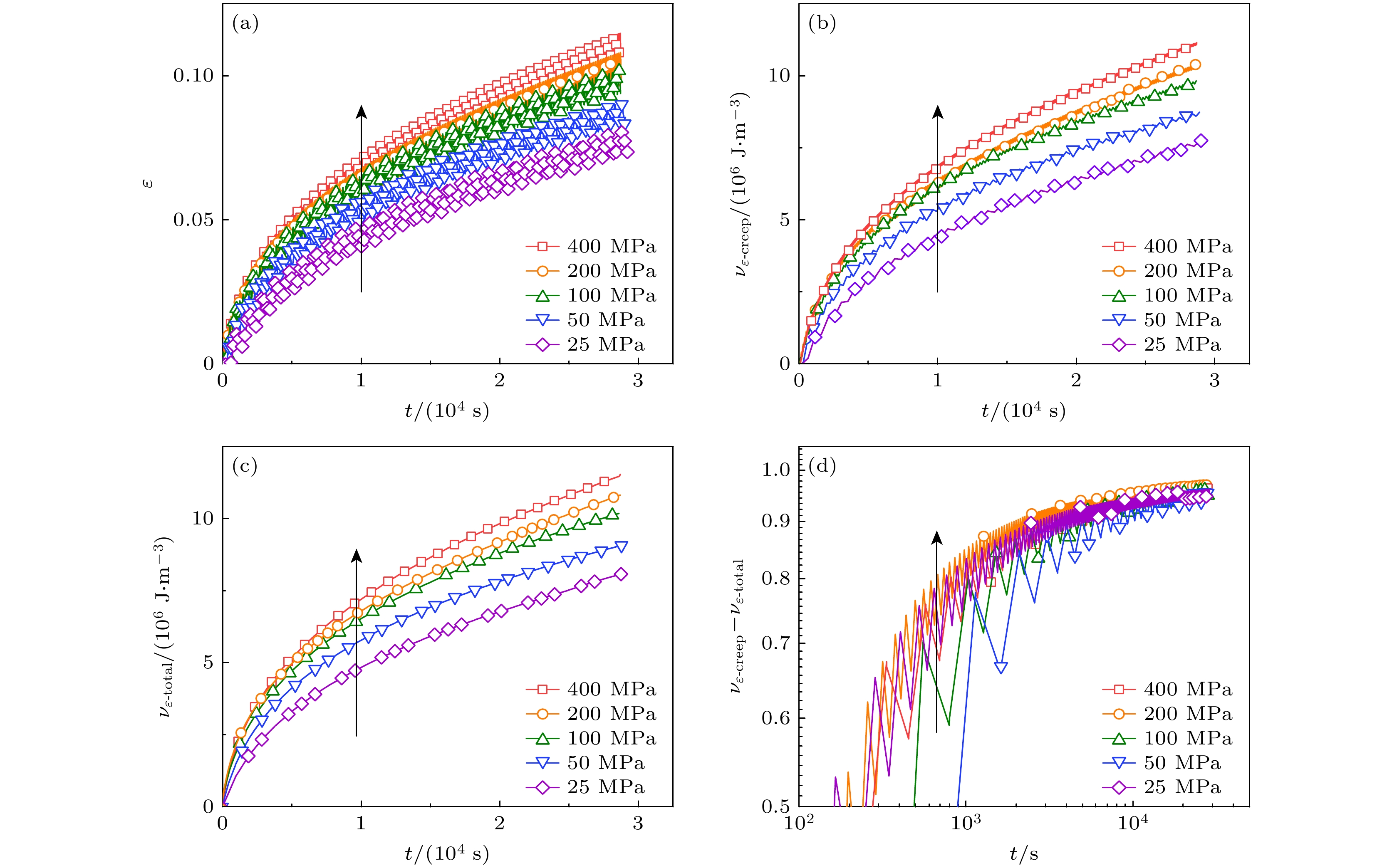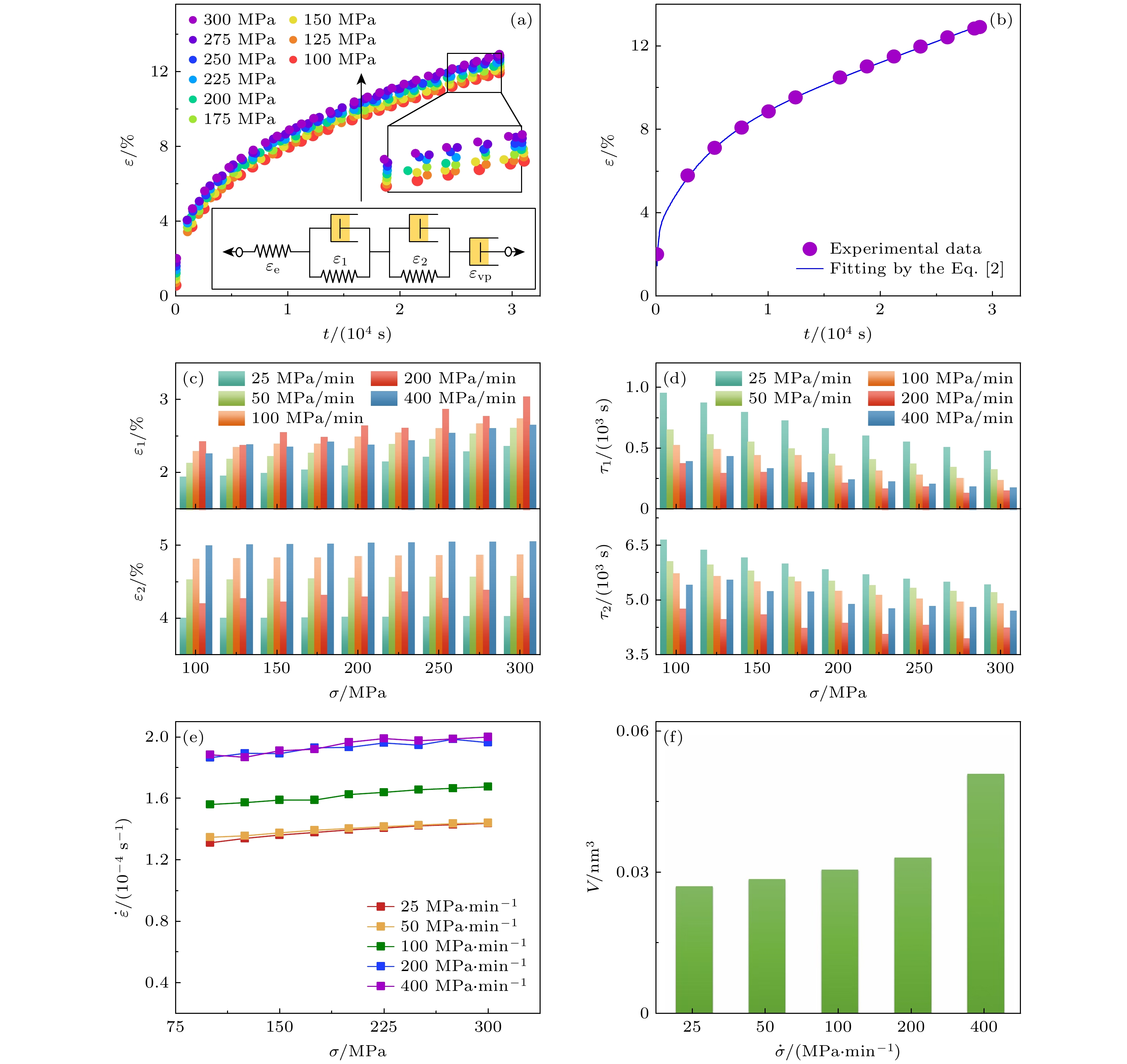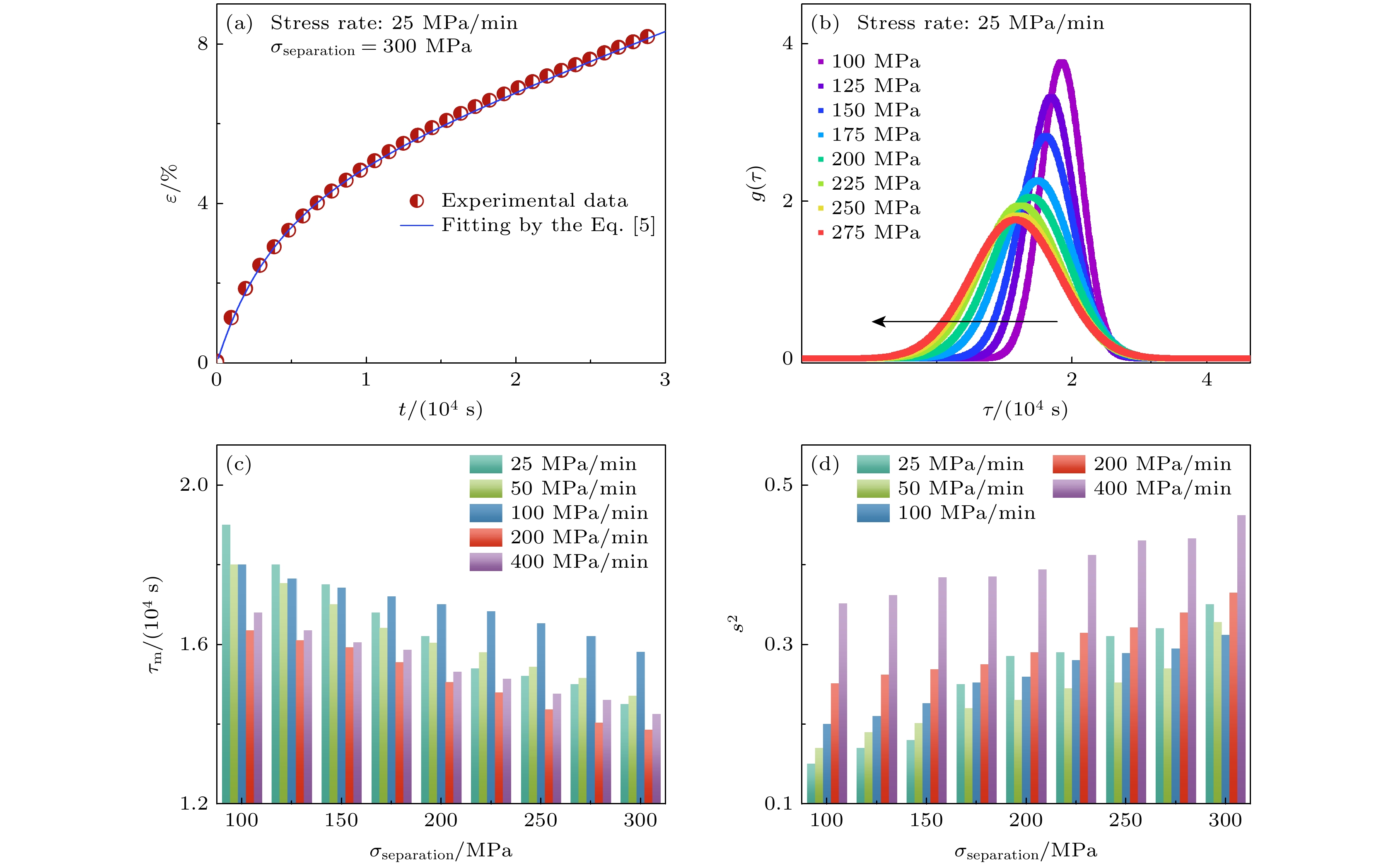-
物理老化很大程度上限制了非晶合金工程应用, 力学激励是一种有效的调控非晶合金能量状态并克服此问题的手段. 本文以Pd20Pt20Cu20Ni20P20非晶合金为模型体系, 使用动态力学分析仪开展高温线性机械循环-回复实验, 基于两相Kelvin模型和特征时间连续谱, 探索了非晶合金机械循环过程中的变形特征及年轻化机制. 结果表明, 机械循环过程中应变和应变速率随机械循环强度提高而增加, 循环加载耗散分量在热力学能量转换中起主导作用. 提高机械循环强度可促进黏弹性变形, 激活非晶合金固有的缺陷, 增加动力学非均匀性, 导致非晶合金变形更倾向于流动的液体. 借助差示扫描量热仪建立了非晶合金变形和能量状态的内禀性关联, 机械循环过程中年轻化起源于黏弹性应变诱导吸热过程. 相较于传统蠕变变形, 机械循环具有更高的年轻化潜力. 该研究为高温流变调控非晶合金的能量状态提供了理论依据, 为进一步理解非晶合金序微观结构非均匀性和年轻化之间的关联提供新的思路.The engineering applications of amorphous alloys are largely restricted by structural relaxation. Notably, the dissipative component of cyclic loading dominates the thermodynamic energy in practical applications of amorphous alloys. Mechanical rejuvenation, achieved through cyclic loading, offers an effective solution to this problem. In this study, we systematically investigate the deformation characteristics and rejuvenation mechanism of Pd20Pt20Cu20Ni20P20 amorphous alloy under mechanical cycling using dynamic mechanical analysis (DMA). By employing a two-phase Kelvin model and continuous relaxation time spectrum, we elucidate the interplay between mechanical deformation and energy dissipation during cyclic loading. The experimental results demonstrate that the strain rate increases significantly with the intensity of mechanical cycling, indicating enhanced dynamic activity in the glassy matrix. At higher cycling intensities, anelastic deformation is promoted, activating a broader spectrum of defects and amplifying dynamic heterogeneity. Through differential scanning calorimetry (DSC), we establish a quantitative correlation between deformation and energetic state, revealing that rejuvenation originates from internal heating induced by anelastic strain. A comparative analysis with creep deformation reveals that mechanical cycling exhibits a superior rejuvenation potential, attributed to its ability to periodically excite multi-scale defect clusters and sustain non-equilibrium states. The key findings of this work include: 1) Deformation mechanism: Cyclic loading enhances atomic mobility and facilitates deformation unit activation; 2) Energy landscape: The enthalpy change (ΔH) measured by DSC provides a direct metric for rejuvenation efficiency; 3) Dynamic heterogeneity: Mechanical cycling broadens the relaxation time spectrum, reflecting increased dynamic heterogeneity.
-
Keywords:
- amorphous alloys /
- mechanical cycling /
- rejuvenation /
- relaxation
[1] Zhou Z Y, Yang Q, Yu H B 2024 Prog. Mater. Sci. 145 101311
 Google Scholar
Google Scholar
[2] Li F, Zhang Z, Liu H, Zhu W, Wang T, Park M, Zhang J, Bönninghoff N, Feng X, Zhang H, Luan J, Wang J, Liu X, Chang T, Chu J P, Lu Y, Liu Y, Guan P, Yang Y 2024 Nat. Mater. 23 52
 Google Scholar
Google Scholar
[3] 王壮, 金凡, 李伟, 阮嘉艺, 王龙飞, 吴雪莲, 张义坤, 袁晨晨 2024 物理学报 73 217101
 Google Scholar
Google Scholar
Wang Z, Jin F, Li W, Ruan J Y, Wang L F, Wu X L, Zhang Y K, Yuan C C 2024 Acta Phys. Sin. 73 217101
 Google Scholar
Google Scholar
[4] 姜晓月, 黄志敏, 王璇, 张响, 杨卫明, 刘海顺 2025 物理学报 74 017501
 Google Scholar
Google Scholar
Jiang X Y, Huang Z M, Wang X, Zhang X, Yang W M, Liu H S 2025 Acta Phys. Sin. 74 017501
 Google Scholar
Google Scholar
[5] Şopu D, Yuan X, Spieckermann F, Eckert J 2024 Acta Mater. 275 120033
 Google Scholar
Google Scholar
[6] 梁淑一, 张浪渟, 朱航辰, 邢光辉, 乔吉超 2025 物理学报 74 136401
 Google Scholar
Google Scholar
Liang S Y, Zhang L T, Zhu H C, Xing G H, Qiao J C 2025 Acta Phys. Sin. 74 136401
 Google Scholar
Google Scholar
[7] Deshmukh A A, Ranganathan R 2025 J. Mater. Sci. Technol. 204 127
 Google Scholar
Google Scholar
[8] Yang C, Zhou H B, Duan J, Cai S L, Ding G, Zhang B B, Shi C J, Dai L H, Wilde G, Jiang M Q 2025 Fundam. Res. https://doi.org/10.1016/j.fmre.2025.03.008
[9] Houghton O S, Greer A L 2025 Acta Mater. 288 120862
 Google Scholar
Google Scholar
[10] Riechers B, Das A, Rashidi R, Dufresne E, Maaß R 2025 Mater. Today 82 92
 Google Scholar
Google Scholar
[11] Balal A H, Bian X L, Han D X, Jia Y F, Ali S, Jia Y D, Wang G 2024 Mater. Charact. 212 113977
 Google Scholar
Google Scholar
[12] Yang Y, Geng J, Cao Y, Fan L, Shi B 2025 Scr. Mater. 256 116418
 Google Scholar
Google Scholar
[13] Yang Z Y, Dai L H 2022 Phys Rev. Mater. 6 L100602
 Google Scholar
Google Scholar
[14] Cheng Y, Shen Y, An Q, Jiang M, Huang C, Goddard W A, Wu X 2025 Extreme Mech. Lett. 74 102280
 Google Scholar
Google Scholar
[15] Wang C, Yu J, Lai J, Wang B, Zhao F, Jiang Z, Xiao Z 2025 Appl. Surf. Sci. 686 162105
 Google Scholar
Google Scholar
[16] Li X X, Wang J G, Ke H B, Yang C, Wang W H 2022 Mater. Today Phys. 27 100782
 Google Scholar
Google Scholar
[17] Pan J, Wang Y X, Guo Q, Zhang D, Greer A L, Li Y 2018 Nat. Commun. 9 560
 Google Scholar
Google Scholar
[18] Ross P, Küchemann S, Derlet P M, Yu H, Arnold W, Liaw P, Samwer K, Maass R 2017 Acta Mater. 138 111
 Google Scholar
Google Scholar
[19] Wang W H 2019 Prog. Mater. Sci. 106 100561
 Google Scholar
Google Scholar
[20] Costa M B, Londoño J J, Blatter A, Hariharan A, Gebert A, Carpenter M A, Greer A L 2023 Acta Mater. 244 118551
 Google Scholar
Google Scholar
[21] Gao Y, Ding G, Yang C, Zhang B B, Shi C J, Dai L H, Jiang M Q 2023 J. Non-Cryst. Solids 615 122410
 Google Scholar
Google Scholar
[22] Zhang L T, Wang Y J, Pineda E, Yang Y, Qiao J C 2022 Int. J. Plast. 157 103402
 Google Scholar
Google Scholar
[23] Sun Y H, Concustell A, Greer A L 2016 Nat. Rev. Mater. 1 16039
 Google Scholar
Google Scholar
[24] Liang S Y, Zhang L T, Wang B, Wang Y J, Yang Y, Pineda E, Qiao J C 2025 International Journal of Mechanical Sciences 302 110573
 Google Scholar
Google Scholar
[25] Takeuchi A, Chen N, Wada T, Yokoyama Y, Kato H, Inoue A, Yeh J W 2011 Intermetallics 19 1546
 Google Scholar
Google Scholar
[26] Wu Y, Ertekin E, Sehitoglu H 2017 Acta Mater. 135 158
 Google Scholar
Google Scholar
[27] Xing G H, Hao Q, Lü G J, Zhu F, Wang Y J, Yang Y, Pineda E, Qiao J C 2025 J. Mater. Sci. Technol. 218 135
 Google Scholar
Google Scholar
[28] Zhang L T, Wang Y J, Yang Y, Wada T, Kato H, Qiao J C 2024 Int. J. Mech. Sci. 281 109661
 Google Scholar
Google Scholar
[29] Khonik V, Kobelev N 2019 Metal 9 605
 Google Scholar
Google Scholar
[30] Qiao J C, Chen Y X, Pelletier J M, Kato H, Crespo D, Yao Y, Khonik V A 2018 Mater. Sci. Eng. 719 164
 Google Scholar
Google Scholar
[31] Wang Z, Wang W H 2019 Nat. Sci. Rev. 6 304
 Google Scholar
Google Scholar
[32] Şopu D 2023 J. Alloys Compd. 960 170585
 Google Scholar
Google Scholar
[33] Wang Q, Zhang S T, Yang Y, Dong Y D, Liu C T, Lu J 2015 Nat. Commun. 6 7876
 Google Scholar
Google Scholar
[34] Schuh C A, Lund A C, Nieh T G 2004 Acta Mater. 52 5879
 Google Scholar
Google Scholar
[35] Yu P F, Feng S D, Xu G S, Guo X L, Wang Y Y, Zhao W, Qi L, Li G, Liaw P K, Liu R P 2014 Scr. Mater. 90 45
 Google Scholar
Google Scholar
[36] Liang S Y, Zhang L T, Wang Y J, Wang B, Pelletier J M, Qiao J C 2024 Int. J. Fatigue 187 108446
 Google Scholar
Google Scholar
[37] Liang S Y, Zhu F, Wang Y J, Pineda E, Wada T, Kato H, Qiao J C 2024 Int. J. Eng. Sci. 205 104146
 Google Scholar
Google Scholar
[38] Castellero A, Moser B, Uhlenhaut D I, Torre F H D, Löffler J F 2008 Acta Mater. 56 3777
 Google Scholar
Google Scholar
[39] Yuan C C, Lv Z W, Li X, Pang C M, Liu R, Yang C, Ma J, Zhu W W, Huang B, Ke H B 2023 Intermetallics 153 107803
 Google Scholar
Google Scholar
[40] Zhang L T, Wang Y J, Nabahat M, Pineda E, Yang Y, Pelletier J M, Crespo D, Qiao J C 2024 Int. J. Plast. 174 103923
 Google Scholar
Google Scholar
[41] Zhang L T, Wang Y J, Pineda E, Kato H, Yang Y, Qiao J C 2022 Scr. Mater. 214 114673
 Google Scholar
Google Scholar
[42] Wang W H, Yang Y, Nieh T G, Liu C T 2015 Intermetallics 67 81
 Google Scholar
Google Scholar
[43] Ge T P, Wang W H, Bai H Y 2016 J. Appl. Phys. 119 204905
 Google Scholar
Google Scholar
[44] Tsai P, Kranjc K, Flores K M 2017 Acta Mater. 139 11
 Google Scholar
Google Scholar
[45] Zella L, Moon J, Keffer D, Egami T 2022 Acta Mater. 239 118254
 Google Scholar
Google Scholar
[46] Monnier X, Cangialosi D, Ruta B, Busch R, Gallino I 2020 Sci. Adv. 6 eaay1454
 Google Scholar
Google Scholar
[47] Luo Q, Zhang Z, Li D, Luo P, Wang W, Shen B 2022 Nano Lett. 22 2867
 Google Scholar
Google Scholar
[48] Ketov S V, Sun Y H, Nachum S, Lu Z, Checchi A, Beraldin A R, Bai H Y, Wang W H, Louzguine Luzgin D V, Carpenter M A, Greer A L 2015 Nature 524 200
 Google Scholar
Google Scholar
-
图 2 不同应力速率条件下机械循环过程中Pd20Pt20Cu20Ni20P20非晶合金(a)应变、(b)蠕变耗能、(c)总应变耗能和(d)蠕变耗散分量权重系数随时间的演化
Fig. 2. Evolution of the weight coefficients of (a) strain, (b) creep energy, (c) total strain energy dissipation, and (d) creep dissipation component of Pd20Pt20Cu20Ni20P20 amorphous alloy during mechanical cycling at different stress rates.
图 3 200 MPa/min条件下非晶合金的瞬时应力(a)及其对应的拟合曲线(b); (c)应力ε值、(d)特征弛豫时间$ \tau $值、(e)斜率随时间的演化; (f)激活体积随应力速率的演化
Fig. 3. (a) Separation stress of amorphous alloy at 200 MPa/min and (b) its corresponding fitting curve; (c) stress value, (d) characteristic relaxation time value, (e) slope evolution over time; (f) evolution of activation volume with stress rate.
图 4 (a)典型蠕变曲线及其对应的拟合曲线; (b) 25 MPa/min条件下非晶合金瞬时应力的高斯分布拟合结果; 拟合弛豫时间的(c)均值、(d)方差
Fig. 4. (a) Typical creep curves and their corresponding fitting curves; (b) Gaussian distribution fitting results of separation stress of amorphous alloys at 25 MPa/min; (c) means, (d) variance of fitted relaxation times.
图 5 (a)应力速率200 MPa/min的样品机械循环-回复过程中黏弹性、黏塑性和能量损耗随回复时间演化过程, 插图为应力速率200 MPa/min的样品机械循环-回复过程中应变随时间的演化; (b)机械循环、蠕变分别回复8 h样品DSC曲线
Fig. 5. (a) Evolution of viscoelasticity, viscoplasticity and energy loss with response time during mechanical cycling-response of samples with a stress rate of 200 MPa/min, and the inset shows the evolution of strain with time during mechanical cycling-response of samples with a stress rate of 200 MPa/min; (b) DSC curves of samples responding to mechanical cycling and creep for 8 h, respectively.
-
[1] Zhou Z Y, Yang Q, Yu H B 2024 Prog. Mater. Sci. 145 101311
 Google Scholar
Google Scholar
[2] Li F, Zhang Z, Liu H, Zhu W, Wang T, Park M, Zhang J, Bönninghoff N, Feng X, Zhang H, Luan J, Wang J, Liu X, Chang T, Chu J P, Lu Y, Liu Y, Guan P, Yang Y 2024 Nat. Mater. 23 52
 Google Scholar
Google Scholar
[3] 王壮, 金凡, 李伟, 阮嘉艺, 王龙飞, 吴雪莲, 张义坤, 袁晨晨 2024 物理学报 73 217101
 Google Scholar
Google Scholar
Wang Z, Jin F, Li W, Ruan J Y, Wang L F, Wu X L, Zhang Y K, Yuan C C 2024 Acta Phys. Sin. 73 217101
 Google Scholar
Google Scholar
[4] 姜晓月, 黄志敏, 王璇, 张响, 杨卫明, 刘海顺 2025 物理学报 74 017501
 Google Scholar
Google Scholar
Jiang X Y, Huang Z M, Wang X, Zhang X, Yang W M, Liu H S 2025 Acta Phys. Sin. 74 017501
 Google Scholar
Google Scholar
[5] Şopu D, Yuan X, Spieckermann F, Eckert J 2024 Acta Mater. 275 120033
 Google Scholar
Google Scholar
[6] 梁淑一, 张浪渟, 朱航辰, 邢光辉, 乔吉超 2025 物理学报 74 136401
 Google Scholar
Google Scholar
Liang S Y, Zhang L T, Zhu H C, Xing G H, Qiao J C 2025 Acta Phys. Sin. 74 136401
 Google Scholar
Google Scholar
[7] Deshmukh A A, Ranganathan R 2025 J. Mater. Sci. Technol. 204 127
 Google Scholar
Google Scholar
[8] Yang C, Zhou H B, Duan J, Cai S L, Ding G, Zhang B B, Shi C J, Dai L H, Wilde G, Jiang M Q 2025 Fundam. Res. https://doi.org/10.1016/j.fmre.2025.03.008
[9] Houghton O S, Greer A L 2025 Acta Mater. 288 120862
 Google Scholar
Google Scholar
[10] Riechers B, Das A, Rashidi R, Dufresne E, Maaß R 2025 Mater. Today 82 92
 Google Scholar
Google Scholar
[11] Balal A H, Bian X L, Han D X, Jia Y F, Ali S, Jia Y D, Wang G 2024 Mater. Charact. 212 113977
 Google Scholar
Google Scholar
[12] Yang Y, Geng J, Cao Y, Fan L, Shi B 2025 Scr. Mater. 256 116418
 Google Scholar
Google Scholar
[13] Yang Z Y, Dai L H 2022 Phys Rev. Mater. 6 L100602
 Google Scholar
Google Scholar
[14] Cheng Y, Shen Y, An Q, Jiang M, Huang C, Goddard W A, Wu X 2025 Extreme Mech. Lett. 74 102280
 Google Scholar
Google Scholar
[15] Wang C, Yu J, Lai J, Wang B, Zhao F, Jiang Z, Xiao Z 2025 Appl. Surf. Sci. 686 162105
 Google Scholar
Google Scholar
[16] Li X X, Wang J G, Ke H B, Yang C, Wang W H 2022 Mater. Today Phys. 27 100782
 Google Scholar
Google Scholar
[17] Pan J, Wang Y X, Guo Q, Zhang D, Greer A L, Li Y 2018 Nat. Commun. 9 560
 Google Scholar
Google Scholar
[18] Ross P, Küchemann S, Derlet P M, Yu H, Arnold W, Liaw P, Samwer K, Maass R 2017 Acta Mater. 138 111
 Google Scholar
Google Scholar
[19] Wang W H 2019 Prog. Mater. Sci. 106 100561
 Google Scholar
Google Scholar
[20] Costa M B, Londoño J J, Blatter A, Hariharan A, Gebert A, Carpenter M A, Greer A L 2023 Acta Mater. 244 118551
 Google Scholar
Google Scholar
[21] Gao Y, Ding G, Yang C, Zhang B B, Shi C J, Dai L H, Jiang M Q 2023 J. Non-Cryst. Solids 615 122410
 Google Scholar
Google Scholar
[22] Zhang L T, Wang Y J, Pineda E, Yang Y, Qiao J C 2022 Int. J. Plast. 157 103402
 Google Scholar
Google Scholar
[23] Sun Y H, Concustell A, Greer A L 2016 Nat. Rev. Mater. 1 16039
 Google Scholar
Google Scholar
[24] Liang S Y, Zhang L T, Wang B, Wang Y J, Yang Y, Pineda E, Qiao J C 2025 International Journal of Mechanical Sciences 302 110573
 Google Scholar
Google Scholar
[25] Takeuchi A, Chen N, Wada T, Yokoyama Y, Kato H, Inoue A, Yeh J W 2011 Intermetallics 19 1546
 Google Scholar
Google Scholar
[26] Wu Y, Ertekin E, Sehitoglu H 2017 Acta Mater. 135 158
 Google Scholar
Google Scholar
[27] Xing G H, Hao Q, Lü G J, Zhu F, Wang Y J, Yang Y, Pineda E, Qiao J C 2025 J. Mater. Sci. Technol. 218 135
 Google Scholar
Google Scholar
[28] Zhang L T, Wang Y J, Yang Y, Wada T, Kato H, Qiao J C 2024 Int. J. Mech. Sci. 281 109661
 Google Scholar
Google Scholar
[29] Khonik V, Kobelev N 2019 Metal 9 605
 Google Scholar
Google Scholar
[30] Qiao J C, Chen Y X, Pelletier J M, Kato H, Crespo D, Yao Y, Khonik V A 2018 Mater. Sci. Eng. 719 164
 Google Scholar
Google Scholar
[31] Wang Z, Wang W H 2019 Nat. Sci. Rev. 6 304
 Google Scholar
Google Scholar
[32] Şopu D 2023 J. Alloys Compd. 960 170585
 Google Scholar
Google Scholar
[33] Wang Q, Zhang S T, Yang Y, Dong Y D, Liu C T, Lu J 2015 Nat. Commun. 6 7876
 Google Scholar
Google Scholar
[34] Schuh C A, Lund A C, Nieh T G 2004 Acta Mater. 52 5879
 Google Scholar
Google Scholar
[35] Yu P F, Feng S D, Xu G S, Guo X L, Wang Y Y, Zhao W, Qi L, Li G, Liaw P K, Liu R P 2014 Scr. Mater. 90 45
 Google Scholar
Google Scholar
[36] Liang S Y, Zhang L T, Wang Y J, Wang B, Pelletier J M, Qiao J C 2024 Int. J. Fatigue 187 108446
 Google Scholar
Google Scholar
[37] Liang S Y, Zhu F, Wang Y J, Pineda E, Wada T, Kato H, Qiao J C 2024 Int. J. Eng. Sci. 205 104146
 Google Scholar
Google Scholar
[38] Castellero A, Moser B, Uhlenhaut D I, Torre F H D, Löffler J F 2008 Acta Mater. 56 3777
 Google Scholar
Google Scholar
[39] Yuan C C, Lv Z W, Li X, Pang C M, Liu R, Yang C, Ma J, Zhu W W, Huang B, Ke H B 2023 Intermetallics 153 107803
 Google Scholar
Google Scholar
[40] Zhang L T, Wang Y J, Nabahat M, Pineda E, Yang Y, Pelletier J M, Crespo D, Qiao J C 2024 Int. J. Plast. 174 103923
 Google Scholar
Google Scholar
[41] Zhang L T, Wang Y J, Pineda E, Kato H, Yang Y, Qiao J C 2022 Scr. Mater. 214 114673
 Google Scholar
Google Scholar
[42] Wang W H, Yang Y, Nieh T G, Liu C T 2015 Intermetallics 67 81
 Google Scholar
Google Scholar
[43] Ge T P, Wang W H, Bai H Y 2016 J. Appl. Phys. 119 204905
 Google Scholar
Google Scholar
[44] Tsai P, Kranjc K, Flores K M 2017 Acta Mater. 139 11
 Google Scholar
Google Scholar
[45] Zella L, Moon J, Keffer D, Egami T 2022 Acta Mater. 239 118254
 Google Scholar
Google Scholar
[46] Monnier X, Cangialosi D, Ruta B, Busch R, Gallino I 2020 Sci. Adv. 6 eaay1454
 Google Scholar
Google Scholar
[47] Luo Q, Zhang Z, Li D, Luo P, Wang W, Shen B 2022 Nano Lett. 22 2867
 Google Scholar
Google Scholar
[48] Ketov S V, Sun Y H, Nachum S, Lu Z, Checchi A, Beraldin A R, Bai H Y, Wang W H, Louzguine Luzgin D V, Carpenter M A, Greer A L 2015 Nature 524 200
 Google Scholar
Google Scholar
计量
- 文章访问数: 4449
- PDF下载量: 139
- 被引次数: 0














 下载:
下载:




